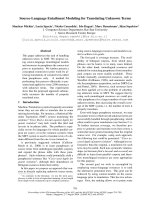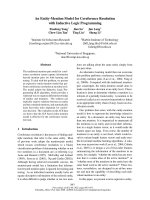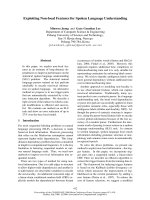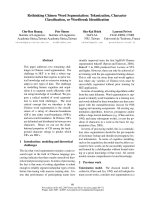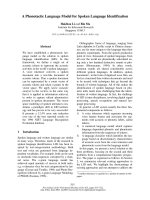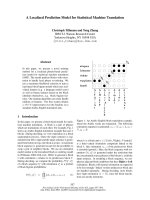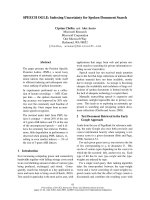Báo cáo khoa học: "Experimenting with Distant Supervision for Emotion Classification" ppt
Bạn đang xem bản rút gọn của tài liệu. Xem và tải ngay bản đầy đủ của tài liệu tại đây (149.02 KB, 10 trang )
Proceedings of the 13th Conference of the European Chapter of the Association for Computational Linguistics, pages 482–491,
Avignon, France, April 23 - 27 2012.
c
2012 Association for Computational Linguistics
Experimenting with Distant Supervision for Emotion Classification
Matthew Purver
∗
and Stuart Battersby
†
∗
Interaction Media and Communication Group
†
Chatterbox Analytics
School of Electronic Engineering and Computer Science
Queen Mary University of London
Mile End Road, London E1 4NS, UK
Abstract
We describe a set of experiments using au-
tomatically labelled data to train supervised
classifiers for multi-class emotion detection
in Twitter messages with no manual inter-
vention. By cross-validating between mod-
els trained on different labellings for the
same six basic emotion classes, and testing
on manually labelled data, we conclude that
the method is suitable for some emotions
(happiness, sadness and anger) but less able
to distinguish others; and that different la-
belling conventions are more suitable for
some emotions than others.
1 Introduction
We present a set of experiments into classify-
ing Twitter messages into the six basic emotion
classes of (Ekman, 1972). The motivation behind
this work is twofold: firstly, to investigate the pos-
sibility of detecting emotions of multiple classes
(rather than purely positive or negative sentiment)
in such short texts; and secondly, to investigate
the use of distant supervision to quickly bootstrap
large datasets and classifiers without the need for
manual annotation.
Text classification according to emotion and
sentiment is a well-established research area. In
this and other areas of text analysis and classifica-
tion, recent years have seen a rise in use of data
from online sources and social media, as these
provide very large, often freely available datasets
(see e.g. (Eisenstein et al., 2010; Go et al., 2009;
Pak and Paroubek, 2010) amongst many others).
However, one of the challenges this poses is that
of data annotation: given very large amounts of
data, often consisting of very short texts, written
in unconventional style and without accompany-
ing metadata, audio/video signals or access to the
author for disambiguation, how can we easily pro-
duce a gold-standard labelling for training and/or
for evaluation and test? One possible solution
that is becoming popular is crowd-sourcing the la-
belling task, as the easy access to very large num-
bers of annotators provided by tools such as Ama-
zon’s Mechanical Turk can help with the problem
of dataset size; however, this has its own attendant
problems of annotator reliability (see e.g. (Hsueh
et al., 2009)), and cannot directly help with the in-
herent problem of ambiguity – using many anno-
tators does not guarantee that they can understand
or correctly assign the author’s intended interpre-
tation or emotional state.
In this paper, we investigate a different ap-
proach via distant supervision (see e.g. (Mintz
et al., 2009)). By using conventional markers of
emotional content within the texts themselves as
a surrogate for explicit labels, we can quickly re-
trieve large subsets of (noisily) labelled data. This
approach has the advantage of giving us direct
access to the authors’ own intended interpreta-
tion or emotional state, without relying on third-
party annotators. Of course, the labels themselves
may be noisy: ambiguous, vague or not having
a direct correspondence with the desired classi-
fication. We therefore experiment with multiple
such conventions with apparently similar mean-
ings – here, emoticons (following (Read, 2005))
and Twitter hashtags – allowing us to examine the
similarity of classifiers trained on independent la-
bels but intended to detect the same underlying
class. We also investigate the precision and cor-
respondence of particular labels with the desired
emotion classes by testing on a small set of man-
482
ually labelled data.
We show that the success of this approach de-
pends on both the conventional markers chosen
and the emotion classes themselves. Some emo-
tions are both reliably marked by different con-
ventions and distinguishable from other emotions;
this seems particularly true for happiness, sadness
and anger, indicating that this approach can pro-
vide not only the basic distinction required for
sentiment analysis but some more finer-grained
information. Others are either less distinguishable
from short text messages, or less reliably marked.
2 Related Work
2.1 Emotion and Sentiment Classification
Much research in this area has concentrated on the
related tasks of subjectivity classification (distin-
guishing objective from subjective texts – see e.g.
(Wiebe and Riloff, 2005)); and sentiment classifi-
cation (classifying subjective texts into those that
convey positive, negative and neutral sentiment –
see e.g. (Pang and Lee, 2008)). We are interested
in emotion detection: classifying subjective texts
according to a finer-grained classification of the
emotions they convey, and thus providing richer
and more informative data for social media anal-
ysis than simple positive/negative sentiment. In
this study we confine ourselves to the six basic
emotions identified by Ekman (1972) as being
common across cultures; other finer-grained clas-
sifications are of course available.
2.1.1 Emotion Classification
The task of emotion classification is by nature
a multi-class problem, and classification experi-
ments have therefore achieved lower accuracies
than seen in the binary problems of sentiment and
subjectivity classification. Danisman and Alpko-
cak (2008) used vector space models for the same
six-way emotion classification we examine here,
and achieved F-measures around 32%; Seol et al.
(2008) used neural networks for an 8-way clas-
sification (hope, love, thank, neutral, happy, sad,
fear, anger) and achieved per-class accuracies of
45% to 65%. Chuang and Wu (2004) used su-
pervised classifiers (SVMs) and manually defined
keyword features over a seven-way classification
consisting of the same six-class taxonomy plus a
neutral category, and achieved an average accu-
racy of 65.5%, varying from 56% for disgust to
74% for anger. However, they achieved signifi-
cant improvements using acoustic features avail-
able in their speech data, improving accuracies up
to a maximum of 81.5%.
2.2 Conventions
As we are using text data, such intonational and
prosodic cues are unavailable, as are the other
rich sources of emotional cues we obtain from
gesture, posture and facial expression in face-to-
face communication. However, the prevalence of
online text-based communication has led to the
emergence of textual conventions understood by
the users to perform some of the same functions
as these acoustic and non-verbal cues. The most
familiar of these is the use of emoticons, either
Western-style (e.g. :), :-( etc.) or Eastern-style
(e.g. (ˆ_ˆ), (>_<) etc.). Other conventions
have emerged more recently for particular inter-
faces or domains; in Twitter data, one common
convention is the use of hashtags to add or em-
phasise emotional content – see (1).
(1) a. Best day in ages! #Happy :)
b. Gets so #angry when tutors don’t email
back Do you job idiots!
Linguistic and social research into the use of
such conventions suggests that their function is
generally to emphasise or strengthen the emo-
tion or sentiment conveyed by a message, rather
than to add emotional content which would not
otherwise be present. Walther and D’Addario
(2001) found that the contribution of emoticons
towards the sentiment of a message was out-
weighed by the verbal content, although nega-
tive ones tended to shift interpretation towards the
negative. Ip (2002) experimented with emoticons
in instant messaging, with the results suggesting
that emoticons do not add positivity or negativ-
ity but rather increase valence (making positive
messages more positive and vice versa). Similarly
Derks et al. (2008a; 2008b) found that emoticons
are used in strengthening the intensity of a ver-
bal message (although they serve other functions
such as expressing humour), and hypothesized
that they serve similar functions to actual non-
verbal behavior; Provine et al. (2007) also found
that emoticons are used to “punctuate” messages
rather than replace lexical content, appearing in
similar grammatical locations to verbal laughter
and preserving phrase structure.
483
2.3 Distant Supervision
These findings suggest, of course, that emoticons
and related conventional markers are likely to be
useful features for sentiment and emotion classifi-
cation. They also suggest, though, that they might
be used as surrogates for manual emotion class la-
bels: if their function is often to complement the
verbal content available in messages, they should
give us a way to automatically label messages ac-
cording to emotional class, while leaving us with
messages with enough verbal content to achieve
reasonable classification.
This approach has been exploited in several
ways in recent work; Tanaka et al. (2005) used
Japanese-style emoticons as classification labels,
and Go et al. (2009) and Pak and Paroubek (2010)
used Western-style emoticons to label and classify
Twitter messages according to positive and nega-
tive sentiment, using traditional supervised clas-
sification methods. The highest accuracies ap-
pear to have been achieved by Go et al. (2009),
who used various combinations of features (un-
igrams, bigrams, part-of-speech tags) and clas-
sifiers (Na
¨
ıve Bayes, maximum entropy, and
SVMs), achieving their best accuracy of 83.0%
with unigram and bigram features and a maxi-
mum entropy; using only unigrams with a SVM
classifier achieved only slightly lower accuracy at
82.2%. Ansari (2010) then provides an initial in-
vestigation into applying the same methods to six-
way emotion classification, treating each emotion
independently as a binary classification problem
and showing that accuracy varied with emotion
class as well as with dataset size. The highest ac-
curacies achieved were up to 81%, but these were
on very small datasets (e.g. 81.0% accuracy on
fear, but with only around 200 positive and nega-
tive data instances).
We view this approach as having several ad-
vantages; apart from the ease of data collection
it allows by avoiding manual annotation, it gives
us access to the author’s own intended interpeta-
tions, as the markers are of course added by the
authors themselves at time of writing. In some
cases such as the examples of (1) above, the emo-
tion conveyed may be clear to a third-party anno-
tator; but in others it may not be clear at all with-
out the marker – see (2):
(2) a. Still trying to recover from seeing the
#bluewaffle on my TL #disgusted #sick
b. Leftover ToeJams with Kettle Salt and
Vinegar chips. #stress #sadness #comfort
#letsturnthisfrownupsidedown
3 Methodology
We used a collection of Twitter messages, all
marked with emoticons or hashtags correspond-
ing to one of Ekman (1972)’s six emotion classes.
For emoticons, we used Ansari (2010)’s taxon-
omy, taken from the Yahoo messenger classifica-
tion. For hashtags, we used emotion names them-
selves together with the main related adjective –
both are used commonly on Twitter in slightly
different ways as shown in (3); note that emo-
tion names are often used as marked verbs as well
as nouns. Details of the classes and markers are
given in Table 1.
(3) a. Gets so #angry when tutors don’t email
back Do you job idiots!
b. I’m going to say it, Paranormal Activity
2 scared me and I didn’t sleep well last
night because of it. #fear #demons
c. Girls that sleep w guys without even fully
getting to know them #disgust me
Messages with multiple conventions (see (4))
were collected and used in the experiments, ensur-
ing that the marker being used as a label in a par-
ticular experiment was not available as a feature in
that experiment. Messages with no markers were
not collected. While this prevents us from exper-
imenting with the classification of neutral or ob-
jective messages, it would require manual anno-
tation to distinguish these from emotion-carrying
messages which are not marked. We assume that
any implementation of the techniques we investi-
gate here would be able to use a preliminary stage
of subjectivity and/or sentiment detection to iden-
tify these messages, and leave this aside here.
(4) a. just because people are celebs they dont
reply to your tweets! NOT FAIR #Angry
:( I wish They would reply! #Please
Data was collected from Twitter’s Streaming
API service.
1
This provides a 1-2% random sam-
ple of all tweets with no constraints on language
1
See />streaming-api.
484
Table 1: Conventional markers used for emotion
classes.
happy :-) :) ;-) :D :P 8) 8-| <@o
sad :-( :( ;-( :-< :’(
anger :-@ :@
fear :| :-o :-O
surprise :s :S
disgust :$ +o(
happy #happy #happiness
sad #sad #sadness
anger #angry #anger
fear #scared #fear
surprise #surprised #surprise
disgust #disgusted #disgust
or location. These are collected in near real time
and stored in a local database. An English lan-
guage selection filter was applied; scripts collect-
ing each conventional marker set were alternated
throughout different times of day and days of the
week to avoid any bias associated with e.g. week-
ends or mornings. The numbers of messages col-
lected varied with the popularity of the markers
themselves: for emoticons, we obtained a max-
imum of 837,849 (for happy) and a minimum
of 10,539 for anger; for hashtags, a maximum
of 10,219 for happy and a minimum of 536 for
disgust.
2
Classification in all experiments was using sup-
port vector machines (SVMs) (Vapnik, 1995) via
the LIBSVM implementation of Chang and Lin
(2001) with a linear kernel and unigram features.
Unigram features included all words and hashtags
(other than those used as labels in relevant exper-
iments) after removal of URLs and Twitter user-
names. Some improvement in performance might
be available using more advanced features (e.g.
n-grams), other classification methods (e.g. maxi-
mum entropy, as lexical features are unlikely to be
independent) and/or feature weightings (e.g. the
variant of TFIDF used for sentiment classification
by Martineau (2009)). Here, our interest is more
in the difference between the emotion and con-
vention marker classes - we leave investigation of
2
One possible way to increase dataset sizes for the rarer
markers might be to include synonyms in the hashtag names
used; however, people’s use and understanding of hashtags is
not straightforwardly predictable from lexical form. Instead,
we intend to run a longer-term data gathering exercise.
absolute performance for future work.
4 Experiments
Throughout, the markers (emoticons and/or hash-
tags) used as labels in any experiment were re-
moved before feature extraction in that experi-
ment – labels were not used as features.
4.1 Experiment 1: Emotion detection
To simulate the task of detecting emotion classes
from a general stream of messages, we first built
for each convention type C and each emotion
class E a dataset D
C
E
of size N containing (a)
as positive instances, N/2 messages containing
markers of the emotion class E and no other
markers of type C, and (b) as negative instances,
N/2 messages containing markers of type C of
any other emotion class. For example, the posi-
tive instance set for emoticon-marked anger was
based on those tweets which contained :-@ or
:@, but none of the emoticons from the happy,
sad, surprise, disgust or fear classes;
any hashtags were allowed, including those as-
sociated with emotion classes. The negative in-
stance set contained a representative sample of
the same number of instances, with each having
at least one of the happy, sad, surprise,
disgust or fear emoticons but not containing
:-@ or :@.
This of course excludes messages with no emo-
tional markers; for this to act as an approximation
of the general task therefore requires a assump-
tion that unmarked messages reflect the same dis-
tribution over emotion classes as marked mes-
sages. For emotion-carrying but unmarked mes-
sages, this does seem intuitively likely, but re-
quires investigation. For neutral objective mes-
sages it is clearly false, but as stated above we as-
sume a preliminary stage of subjectivity detection
in any practical application.
Performance was evaluated using 10-fold
cross-validation. Results are shown as the bold
figures in Table 2; despite the small dataset
sizes in some cases, a χ
2
test shows all to be
significantly different from chance. The best-
performing classes show accuracies very similar
to those achieved by Go et al. (2009) for their bi-
nary positive/negative classification, as might be
expected; for emoticon markers, the best classes
are happy, sad and anger; interestingly the
best classes for hashtag markers are not the same
485
Table 2: Experiment 1: Within-class results. Same-
convention (bold) figures are accuracies over 10-fold
cross-validation; cross-convention (italic) figures are
accuracies over full sets.
Train
Convention Test emoticon hashtag
emoticon happy 79.8% 63.5%
emoticon sad 79.9% 65.5%
emoticon anger 80.1% 62.9%
emoticon fear 76.2% 58.5%
emoticon surprise 77.4% 48.2%
emoticon disgust 75.2% 54.6%
hashtag happy 67.7% 82.5%
hashtag sad 67.1% 74.6%
hashtag anger 62.8% 74.7%
hashtag fear 60.6% 77.2%
hashtag surprise 51.9% 67.4%
hashtag disgust 64.6% 78.3%
– happy performs best, but disgust and fear
outperform sad and anger, and surprise
performs particularly badly. For sad, one reason
may be a dual meaning of the tag #sad (one emo-
tional and one expressing ridicule); for anger
one possibility is the popularity on Twitter of the
game “Angry Birds”; for surprise, the data
seems split between two rather distinct usages,
ones expressing the author’s emotion, but one ex-
pressing an intended effect on the audience (see
(5)). However, deeper analysis is needed to estab-
lish the exact causes.
(5) a. broke 100 followers. #surprised im glad
that the HOFF is one of them.
b. Who’s excited for the Big Game? We
know we are AND we have a #surprise
for you!
To investigate whether the different conven-
tion types actually convey similar properties (and
hence are used to mark similar messages) we then
compared these accuracies to those obtained by
training classifiers on the dataset for a different
convention: in other words, for each emotion
class E, train a classifier on dataset D
C1
E
and test
on D
C2
E
. As the training and testing sets are dif-
ferent, we now test on the entire dataset rather
than using cross-validation. Results are shown as
the italic figures in Table 2; a χ
2
test shows all
to be significantly different from the bold same-
convention results. Accuracies are lower overall,
but the highest figures (between 63% and 68%)
are achieved for happy, sad and anger; here
perhaps we can have some confidence that not
only are the markers acting as predictable labels
themselves, but also seem to be labelling the same
thing (and therefore perhaps are actually labelling
the emotion we are hoping to label).
4.2 Experiment 2: Emotion discrimination
To investigate whether these independent clas-
sifiers can be used in multi-class classification
(distinguishing emotion classes from each other
rather than just distinguishing one class from a
general “other” set), we next cross-tested the clas-
sifiers between emotion classes: training models
on one emotion and testing on the others – for
each convention type C and each emotion class
E1, train a classifier on dataset D
C
E1
and test on
D
C
E2
, D
C
E3
etc. The datasets in Experiment 1 had
an uneven balance of emotion classes (including a
high proportion of happy instances) which could
bias results; for this experiment, therefore, we cre-
ated datasets with an even balance of emotions
among the negative instances. For each conven-
tion type C and each emotion class E1, we built
a dataset D
C
E1
of size N containing (a) as pos-
itive instances, N/2 messages containing mark-
ers of the emotion class E1 and no other mark-
ers of type C, and (b) as negative instances, N/2
messages consisting of N/10 messages contain-
ing only markers of class E2, N/10 messages
containing only markers of class E3 etc. Results
were then generated as in Experiment 1.
Within-class results are shown in Table 3 and
are similar to those obtained in Experiment 1;
again, differences between bold/italic results are
statistically significant. Cross-class results are
shown in Table 4. The happy class was well
distinguished from other emotion classes for both
convention types (i.e. cross-class classification
accuracy is low compared to the within-class fig-
ures in italics and parentheses). The sad class
also seems well distinguished when using hash-
tags as labels, although less so when using emoti-
cons. However, other emotion classes show a sur-
prisingly high cross-class performance in many
cases – in other words, they are producing dis-
appointingly similar classifiers.
This poor discrimination for negative emotion
classes may be due to ambiguity or vagueness in
the label, similarity of the verbal content associ-
486
Table 4: Experiment 2: Cross-class results. Same-class figures from 10-fold cross-validation are shown in
(italics) for comparison; all other figures are accuracies over full sets.
Train
Convention Test happy sad anger fear surprise disgust
emoticon happy (78.1%) 17.3% 39.6% 26.7% 28.3% 42.8%
emoticon sad 16.5% (78.9%) 59.1% 71.9% 69.9% 55.5%
emoticon anger 29.8% 67.0% (79.7%) 74.2% 76.4% 67.5%
emoticon fear 27.0% 69.9% 64.4% (75.3%) 74.0% 61.2%
emoticon surprise 25.4% 69.9% 67.7% 76.3% (78.1%) 66.4%
emoticon disgust 42.2% 54.4% 61.1% 64.2% 64.1% (73.9%)
hashtag happy (81.1%) 10.7% 45.3% 47.8% 52.7% 43.4%
hashtag sad 13.8% (77.9%) 47.7% 49.7% 46.5% 54.2%
hashtag anger 44.6% 45.2% (74.3%) 72.0% 63.0% 62.9%
hashtag fear 45.0% 50.4% 68.6% (74.7%) 63.9% 60.7%
hashtag surprise 51.5% 45.7% 67.4% 70.7% (70.2%) 64.2%
hashtag disgust 40.4% 53.5% 74.7% 71.8% 70.8% (74.2%)
Table 3: Experiment 2: Within-class results. Same-
convention (bold) figures are accuracies over 10-fold
cross-validation; cross-convention (italic) figures are
accuracies over full sets.
Train
Convention Test emoticon hashtag
emoticon happy 78.1% 61.2%
emoticon sad 78.9% 60.2%
emoticon anger 79.7% 63.7%
emoticon fear 75.3% 55.9%
emoticon surprise 78.1% 53.1%
emoticon disgust 73.9% 51.5%
hashtag happy 68.7% 81.1%
hashtag sad 65.4% 77.9%
hashtag anger 63.9% 74.3%
hashtag fear 58.9% 74.7%
hashtag surprise 51.8% 70.2%
hashtag disgust 55.4% 74.2%
ated with the emotions, or of genuine frequent co-
presence of the emotions. Given the close lex-
ical specification of emotions in hashtag labels,
the latter reasons seem more likely; however, with
emoticon labels, we suspect that the emoticons
themselves are often used in ambiguous or vague
ways.
As one way of investigating this directly, we
tested classifiers across labelling conventions as
well as across emotion classes, to determine
whether the (lack of) cross-class discrimination
holds across convention marker types. In the
case of ambiguity or vagueness of emoticons,
we would expect emoticon-trained models to fail
to discriminate hashtag-labelled test sets, but
hashtag-trained models to discriminate emoticon-
labelled test sets well; if on the other hand the
cause lies in the overlap of verbal content or the
emotions themselves, the effect should be simi-
lar in either direction. This experiment also helps
determine in more detail whether the labels used
label similar underlying properties.
Table 5 shows the results. For the three classes
happy, sad and perhaps anger, models trained
using emoticon labels do a reasonable job of dis-
tinguishing classes in hashtag-labelled data, and
vice versa. However, for the other classes, dis-
crimination is worse. Emoticon-trained mod-
els appear to give (undesirably) higher perfor-
mance across emotion classes in hashtag-labelled
data (for the problematic non-happy classes).
Hashtag-trained models perform around the ran-
dom 50% level on emoticon-labelled data for
those classes, even when tested on nominally
the same emotion as they are trained on. For
both label types, then, the lower within-class and
higher cross-class performance with these nega-
tive classes (fear, surprise, disgust) sug-
gests that these emotion classes are genuinely
hard to tell apart (they are all negative emotions,
and may use similar words), or are simply of-
ten expressed simultaneously. The higher perfor-
mance of emoticon-trained classifiers compared
to hashtag-trained classifiers, though, also sug-
gests vagueness or ambiguity in emoticons: data
labelled with emoticons nominally thought to be
487
Table 5: Experiment 2: Cross-class, cross-convention results (train on hashtags, test on emoticons and vice
versa). All figures are accuracies over full sets. Accuracies over 60% are shown in bold.
Train
Convention Test happy sad anger fear surprise disgust
emoticon happy 61.2% 40.4% 44.1% 47.4% 52.0% 45.9%
emoticon sad 38.3% 60.2% 55.1% 51.5% 47.1% 53.9%
emoticon anger 47.0% 48.0% 63.7% 56.2% 50.9% 56.6%
emoticon fear 39.8% 57.7% 57.1% 55.9% 50.8% 56.1%
emoticon surprise 43.7% 55.2% 59.2% 58.4% 53.1% 54.0%
emoticon disgust 51.5% 48.0% 53.5% 55.1% 53.1% 51.5%
hashtag happy 68.7% 32.5% 43.6% 32.1% 35.4% 50.4%
hashtag sad 33.8% 65.4% 53.2% 65.0% 61.8% 48.8%
hashtag anger 43.9% 55.5% 63.9% 59.6% 60.4% 53.0%
hashtag fear 44.3% 54.6% 56.1% 58.9% 61.5% 54.3%
hashtag surprise 54.2% 45.3% 49.8% 49.9% 51.8% 52.3%
hashtag disgust 41.5% 57.6% 61.6% 62.2% 59.3% 55.4%
associated with surprise produces classifiers
which perform well on data labelled with many
other hashtag classes, suggesting that those emo-
tions were present in the training data. Con-
versely, the more specific hashtag labels produce
classifiers which perform poorly on data labelled
with emoticons and which thus contains a range
of actual emotions.
4.3 Experiment 3: Manual labelling
To confirm whether either (or both) set of auto-
matic (distant) labels do in fact label the under-
lying emotion class intended, we used human an-
notators via Amazon’s Mechanical Turk to label
a set of 1,000 instances. These instances were all
labelled with emoticons (we did not use hashtag-
labelled data: as hashtags are so lexically close to
the names of the emotion classes being labelled,
their presence may influence labellers unduly)
3
and were evenly distributed across the 6 classes,
in so far as indicated by the emoticons. Labellers
were asked to choose the primary emotion class
(from the fixed set of six) associated with the mes-
sage; they were also allowed to specify if any
other classes were also present. Each data in-
stance was labelled by three different annotators.
Agreement between labellers was poor over-
all. The three annotators unanimously agreed in
only 47% of cases overall; although two of three
agreed in 83% of cases. Agreement was worst
3
Although, of course, one may argue that they do the
same for their intended audience of readers – in which case,
such an effect is legitimate.
for the three classes already seen to be prob-
lematic: surprise, fear and disgust. To
create our dataset for this experiment, we there-
fore took only instances which were given the
same primary label by all labellers – i.e. only
those examples which we could take as reliably
and unambiguously labelled. This gave an un-
balanced dataset, with numbers varying from 266
instances for happy to only 12 instances for
each of surprise and fear. Classifiers were
trained using the datasets from Experiment 2. Per-
formance is shown in Table 6; given the imbal-
ance between class numbers in the test dataset,
evaluation is given as recall, precision and F-score
for the class in question rather than a simple accu-
racy figure (which is biased by the high proportion
of happy examples).
Table 6: Experiment 3: Results on manual labels.
Train Class Precision Recall F-score
emoticon happy 79.4% 75.6% 77.5%
emoticon sad 43.5% 73.2% 54.5%
emoticon anger 62.2% 37.3% 46.7%
emoticon fear 6.8% 63.6% 12.3%
emoticon surprise 15.0% 90.0% 25.7%
emoticon disgust 8.3% 25.0% 12.5%
hashtag happy 78.9% 51.9% 62.6%
hashtag sad 47.9% 81.7% 60.4%
hashtag anger 58.2% 76.0% 65.9%
hashtag fear 10.1% 81.8% 18.0%
hashtag surprise 5.9% 60.0% 10.7%
hashtag disgust 6.7% 66.7% 11.8%
488
Again, results for happy are good, and cor-
respond fairly closely to the levels of accuracy
reported by Go et al. (2009) and others for the
binary positive/negative sentiment detection task.
Emoticons give significantly better performance
than hashtags here. Results for sad and anger
are reasonable, and provide a baseline for fur-
ther experiments with more advanced features and
classification methods once more manually anno-
tated data is available for these classes. In con-
trast, hashtags give much better performance with
these classes than the (perhaps vague or ambigu-
ous) emoticons.
The remaining emotion classes, however, show
poor performance for both labelling conventions.
The observed low precision and high recall can be
adjusted using classifier parameters, but F-scores
are not improved. Note that Experiment 1 shows
that both emoticon and hashtag labels are to some
extent predictable, even for these classes; how-
ever, Experiment 2 shows that they may not be
reliably different to each other, and Experiment 3
tells us that they do not appear to coincide well
with human annotator judgements of emotions.
More reliable labels may therefore be required;
although we do note that the low reliability of
the human annotations for these classes, and the
correspondingly small amount of annotated data
used in this evaluation, means we hesitate to draw
strong conclusions about fear, surprise and
disgust. An approach which considers multi-
ple classes to be associated with individual mes-
sages may also be beneficial: using majority-
decision labels rather than unanimous labels im-
proves F-scores for surprise to 23-35% by in-
cluding many examples also labelled as happy
(although this gives no improvements for other
classes).
5 Survey
To further detemine whether emoticons used
as emotion class labels are ambiguous or vague
in meaning, we set up a web survey to exam-
ine whether people could reliably classify these
emoticons.
5.1 Method
Our survey asked people to match up which of
the six emotion classes (selected from a drop-
down menu) best matched each emoticon. Each
drop-down menu included a ‘Not Sure’ option.
To avoid any effect of ordering, the order of the
emoticon list and each drop-down menu was ran-
domised every time the survey page was loaded.
The survey was distributed via Twitter, Facebook
and academic mailing lists. Respondents were not
given the opportunity to give their own definitions
or to provide finer-grained classifications, as we
wanted to establish purely whether they would re-
liably associate labels with the six emotions in our
taxonomy.
5.2 Results
The survey was completed by 492 individuals;
full results are shown in Table 7. It demonstrated
agreement with the predefined emoticons for sad
and most of the emoticons for happy (people
were unsure what 8-| and <@o meant). For all
the emoticons listed as anger, surprise and
disgust, the survey showed that people are reli-
ably unsure as to what these mean. For the emoti-
con :-o there was a direct contrast between the
defined meaning and the survey meaning; the def-
inition of this emoticon following Ansari (2010)
was fear, but the survey reliably assigned this to
surprise.
Given the small scale of the survey, we hesi-
tate to draw strong conclusions about the emoti-
con meanings themselves (in fact, recent conver-
sations with schoolchildren – see below – have in-
dicated very different interpretations from these
adult survey respondents). However, we do con-
clude that for most emotions outside happy and
sad, emoticons may indeed be an unreliable la-
bel; as hashtags also appear more reliable in the
classification experiments, we expect these to be
a more promising approach for fine-grained emo-
tion discrimination in future.
6 Conclusions
The approach shows reasonable performance at
individual emotion label prediction, for both
emoticons and hashtags. For some emotions (hap-
piness, sadness and anger), performance across
label conventions (training on one, and testing on
the other) is encouraging; for these classes, per-
formance on those manually labelled examples
where annotators agree is also reasonable. This
gives us confidence not only that the approach
produces reliable classifiers which can predict the
labels, but that these classifiers are actually de-
tecting the desired underlying emotional classes,
489
Table 7: Survey results showing the defined emotion, the most popular emotion from the survey, the percentage
of votes this emotion received, and the χ
2
significance test for the distribution of votes. These are indexed by
emoticon.
Emoticon Defined Emotion Survey Emotion % of votes Significance of votes distribution
:-) Happy Happy 94.9 χ
2
= 3051.7 (p < 0.001)
:) Happy Happy 95.5 χ
2
= 3098.2 (p < 0.001)
;-) Happy Happy 87.4 χ
2
= 2541 (p < 0.001)
:D Happy Happy 85.7 χ
2
= 2427.2 (p < 0.001)
:P Happy Happy 59.1 χ
2
= 1225.4 (p < 0.001)
8) Happy Happy 61.9 χ
2
= 1297.4 (p < 0.001)
8-| Happy Not Sure 52.2 χ
2
= 748.6 (p < 0.001)
<@o Happy Not Sure 84.6 χ
2
= 2335.1 (p < 0.001)
:-( Sad Sad 91.3 χ
2
= 2784.2 (p < 0.001)
:( Sad Sad 89.0 χ
2
= 2632.1 (p < 0.001)
;-( Sad Sad 67.9 χ
2
= 1504.9 (p < 0.001)
:-< Sad Sad 56.1 χ
2
= 972.59 (p < 0.001)
:’( Sad Sad 80.7 χ
2
= 2116 (p < 0.001)
:-@ Anger Not Sure 47.8 χ
2
= 642.47 (p < 0.001)
:@ Anger Not Sure 50.4 χ
2
= 691.6 (p < 0.001)
:s Surprise Not Sure 52.2 χ
2
= 757.7 (p < 0.001)
:$ Disgust Not Sure 62.8 χ
2
= 1136 (p < 0.001)
+o( Disgust Not Sure 64.2 χ
2
= 1298.1 (p < 0.001)
:| Fear Not Sure 55.1 χ
2
= 803.41 (p < 0.001)
:-o Fear Surprise 89.2 χ
2
= 2647.8 (p < 0.001)
without requiring manual annotation. We there-
fore plan to pursue this approach with a view to
improving performance by investigating training
with combined mixed-convention datasets, and
cross-training between classifiers trained on sepa-
rate conventions.
However, this cross-convention performance is
much better for some emotions (happiness, sad-
ness and anger) than others (fear, surprise and dis-
gust). Indications are that the poor performance
on these latter emotion classes is to a large de-
gree an effect of ambiguity or vagueness of the
emoticon and hashtag conventions we have used
as labels here; we therefore intend to investi-
gate other conventions with more specific and/or
less ambiguous meanings, and the combination
of multiple conventions to provide more accu-
rately/specifically labelled data. Another possi-
bility might be to investigate approaches to anal-
yse emoticons semantically on the basis of their
shape, or use features of such an analysis – see
(Ptaszynski et al., 2010; Radulovic and Milikic,
2009) for some interesting recent work in this di-
rection.
Acknowledgements
The authors are supported in part by the Engi-
neering and Physical Sciences Research Council
(grants EP/J010383/1 and EP/J501360/1) and the
Technology Strategy Board (R&D grant 700081).
We thank the reviewers for their comments.
References
Saad Ansari. 2010. Automatic emotion tone detection
in twitter. Master’s thesis, Queen Mary University
of London.
Chih-Chung Chang and Chih-Jen Lin, 2001. LIB-
SVM: a library for Support Vector Machines.
Software available at .
edu.tw/
˜
cjlin/libsvm.
Ze-Jing Chuang and Chung-Hsien Wu. 2004. Multi-
modal emotion recognition from speech and text.
Computational Linguistics and Chinese Language
Processing, 9(2):45–62, August.
Taner Danisman and Adil Alpkocak. 2008. Feeler:
Emotion classification of text using vector space
model. In AISB 2008 Convention, Communication,
Interaction and Social Intelligence, volume 2, pages
53–59, Aberdeen.
490
Daantje Derks, Arjan Bos, and Jasper von Grumbkow.
2008a. Emoticons and online message interpreta-
tion. Social Science Computer Review, 26(3):379–
388.
Daantje Derks, Arjan Bos, and Jasper von Grumbkow.
2008b. Emoticons in computer-mediated commu-
nication: Social motives and social context. Cy-
berPsychology & Behavior, 11(1):99–101, Febru-
ary.
Jacob Eisenstein, Brendan O’Connor, Noah A. Smith,
and Eric P. Xing. 2010. A latent variable model
for geographic lexical variation. In Proceedings
of the 2010 Conference on Empirical Methods in
Natural Language Processing, pages 1277–1287,
Cambridge, MA, October. Association for Compu-
tational Linguistics.
Paul Ekman. 1972. Universals and cultural differ-
ences in facial expressions of emotion. In J. Cole,
editor, Nebraska Symposium on Motivation 1971,
volume 19. University of Nebraska Press.
Alec Go, Richa Bhayani, and Lei Huang. 2009. Twit-
ter sentiment classification using distant supervi-
sion. Master’s thesis, Stanford University.
Pei-Yun Hsueh, Prem Melville, and Vikas Sindhwani.
2009. Data quality from crowdsourcing: A study of
annotation selection criteria. In Proceedings of the
NAACL HLT 2009 Workshop on Active Learning for
Natural Language Processing, pages 27–35, Boul-
der, Colorado, June. Association for Computational
Linguistics.
Amy Ip. 2002. The impact of emoticons on affect in-
terpretation in instant messaging. Carnegie Mellon
University.
Justin Martineau. 2009. Delta TFIDF: An improved
feature space for sentiment analysis. Artificial In-
telligence, 29:258–261.
Mike Mintz, Steven Bills, Rion Snow, and Dan Juraf-
sky. 2009. Distant supervision for relation extrac-
tion without labeled data. In Proceedings of ACL-
IJCNLP 2009.
Alexander Pak and Patrick Paroubek. 2010. Twitter
as a corpus for sentiment analysis and opinion min-
ing. In Proceedings of the 7th conference on Inter-
national Language Resources and Evaluation.
Bo Pang and Lillian Lee. 2008. Opinion mining and
sentiment analysis. Foundations and Trends in In-
formation Retrieval, 2(1–2):1–135.
Robert Provine, Robert Spencer, and Darcy Mandell.
2007. Emotional expression online: Emoticons
punctuate website text messages. Journal of Lan-
guage and Social Psychology, 26(3):299–307.
M. Ptaszynski, J. Maciejewski, P. Dybala, R. Rzepka,
and K Araki. 2010. CAO: A fully automatic emoti-
con analysis system based on theory of kinesics. In
Proceedings of The 24th AAAI Conference on Arti-
ficial Intelligence (AAAI-10), pages 1026–1032, At-
lanta, GA.
F. Radulovic and N. Milikic. 2009. Smiley ontology.
In Proceedings of The 1st International Workshop
On Social Networks Interoperability.
Jonathon Read. 2005. Using emoticons to reduce de-
pendency in machine learning techniques for sen-
timent classification. In Proceedings of the 43rd
Meeting of the Association for Computational Lin-
guistics. Association for Computational Linguis-
tics.
Young-Soo Seol, Dong-Joo Kim, and Han-Woo Kim.
2008. Emotion recognition from text using knowl-
edge based ANN. In Proceedings of ITC-CSCC.
Y. Tanaka, H. Takamura, and M. Okumura. 2005. Ex-
traction and classification of facemarks with kernel
methods. In Proceedings of IUI.
Vladimir N. Vapnik. 1995. The Nature of Statistical
Learning Theory. Springer.
Joseph Walther and Kyle D’Addario. 2001. The
impacts of emoticons on message interpretation in
computer-mediated communication. Social Science
Computer Review, 19(3):324–347.
J. Wiebe and E. Riloff. 2005. Creating subjective
and objective sentence classifiers from unannotated
texts . In Proceedings of the 6th International Con-
ference on Computational Linguistics and Intelli-
gent Text Processing (CICLing-05), volume 3406 of
Springer LNCS. Springer-Verlag.
491


